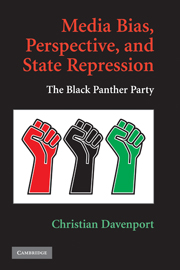Book contents
- Frontmatter
- Contents
- Figures and Tables
- Preface and Acknowledgments
- Media Bias, Perspective, and State Repression
- INTRODUCTION
- Part I Conceptualization
- 1 OBJECTIVITY AND SUBJECTIVITY IN EVENT CATALOGS
- 2 THE RASHOMON EFFECT, OBSERVATION, AND DATA GENERATION
- 3 UNDERSTANDING STATE REPRESSIVE BEHAVIOR
- Part II Cases
- Part III Conclusion
- Appendix: The Black Panther–U.S. Government Event Catalog
- Bibliography
- Index
3 - UNDERSTANDING STATE REPRESSIVE BEHAVIOR
Published online by Cambridge University Press: 05 June 2012
- Frontmatter
- Contents
- Figures and Tables
- Preface and Acknowledgments
- Media Bias, Perspective, and State Repression
- INTRODUCTION
- Part I Conceptualization
- 1 OBJECTIVITY AND SUBJECTIVITY IN EVENT CATALOGS
- 2 THE RASHOMON EFFECT, OBSERVATION, AND DATA GENERATION
- 3 UNDERSTANDING STATE REPRESSIVE BEHAVIOR
- Part II Cases
- Part III Conclusion
- Appendix: The Black Panther–U.S. Government Event Catalog
- Bibliography
- Index
Summary
Repression evokes an image of a central political authority using the formal apparatus of the state to put down rebellions, whether overtly or covertly holding the reins and directing the actions being taken in its defense. Repression is (in a sense) what states do.
Myra Marx Ferree “Soft Repression: Ridicule, Stigma and Silencing in Gender-based Movements” in Repression and Mobilization (2005)State repression is strangely familiar. Almost all individuals feel that they have at least some understanding of what it is. When asked, most identify a few prominent examples, such as the Jewish Holocaust during the Second World War, the counterinsurgent efforts of the U.S. government against radicals during the 1960s and 1970s (COINTELPRO), the police response to protestors in Chicago outside the Democratic National Convention in 1968, the actions of the Apartheid regime in South Africa as it confronted the African National Congress (ANC) in the 1970s and 1980s, the activities undertaken by Rwandan political authorities against ethnic Tutsi and moderate Hutu in 1994, or the action taken by authorities in Darfur against the Fur, Zaghawa, and Massaleit ethnic groups in the early 2000s. There is of course more to repressive behavior than what can be garnered from popular accounts of these isolated events. For example, there are a large number of empirical analyses of event catalogs that are basically hidden within academic journals and behind inaccessible jargon; these reveal systematic patterns in government activity that hold across time, space, and context.
- Type
- Chapter
- Information
- Media Bias, Perspective, and State RepressionThe Black Panther Party, pp. 74 - 90Publisher: Cambridge University PressPrint publication year: 2009



